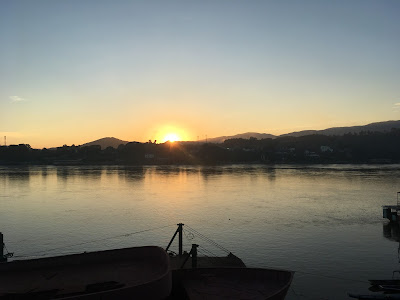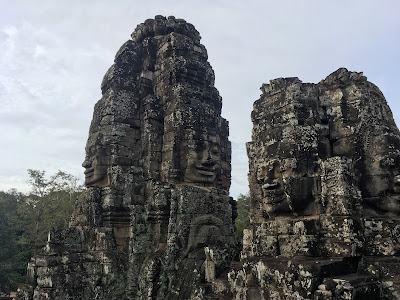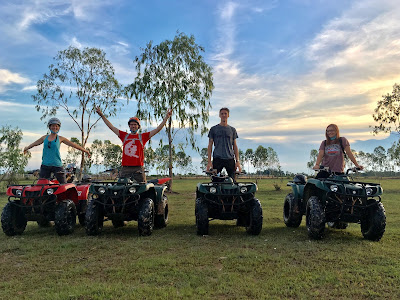I (Kenzi), was really excited to see Hong Kong. You know how some places just sound better to you than others? It seems to me that everyone has specific travel preferences, and they change over time. And Hong Kong has been on my list ever since we visited China in 2011.
 |
| Hong Kong at night from Victoria Peak |
 |
| It is hard to exaggerate how fun it is to ride in the top of a double decker bus. |
 |
| Bill riding in the front of the top level of a double decker bus around Hong Kong. |
We ended up in Hong Kong because we were looking for cheap flights back to the US for the holidays and getting from Hong Kong to LA was relatively cheap, so we decided to spend a couple days there to finish this leg of our round-the-world travels.
Hong Kong did not disappoint. We packed our two days there pretty full which was easy to do. Hong Kong is clean for a huge city, modern, well organized, has nice public bathrooms(!), excellent public transportation, and seems quite diverse.
Hong Kong means "fragrant harbor", which definitely applied in some places. Bill was bothered by the smells on "dried fish street", an entire street full of shops selling every possible variety of dried fish you could imagine, but I thought it was too fascinating to be bothered by the smell.
 |
| Some of the mysterious, smelly treats you can purchase on "Dried Fish Street". |
 |
| More treats from Dried Fish Street. |
We started by visiting the Hong Kong Museum of History, where we spent several hours learning about Hong Kong's interesting history. HK is a series of islands as well as a small chunk of the Chinese mainland. It is some of the most densely populated land in the world, as evidenced by oodles of high rises.
 |
| Bill in front of HK's History Museum |
 |
| This picture doesn't really capture it, but the displays at the museum were really magnificent. |
As for HK's history, there was the Han dynasty, the Tang dynasty, then the Ming dynasty, and the Qing dynasty. The first westerners to the area were the Portuguese in the 1500s. Hong Kong has a deep natural bay making it ideal as a shipping port. The Hong Kong people were doing great, selling lots of goods to the British in the late 1700s/early 1800s and not purchasing much from them, until opium happened. Lots of Chinese, not just the Hong Kong people got addicted to opium. The Qing government tried to stop importing it because of all the problems it was causing, but the Brits waged war, leading to two Opium Wars. At the end of the first Opium War in 1841, Britain ended up occupying Hong Kong island and they established a "Crown colony". There were only about 7,500 people living on Hong Kong island at that time. After the second Opium War, the Brits took over the Kowloon peninsula which is the mainland area just to the north of HK island, as well as a bunch of other islands. In 1898, the Brits got a 99-year lease for the Hong Kong territory from the Qing leadership. The British occupation was not entirely smooth, but could have been worse...
And it got worse... when the Japanese occupied Hong Kong during WWII from 1941-1945. This was a particularly ugly time which involved starvation from food shortages, forced labor, and general suffering for the HK people. The UK resumed control of the HK territory once the war was over in August of 1945. At the end of the war, there were about 600,000 people in the Hong Kong (almost 1/2 of what it was at the beginning of the war).
Hong Kong underwent lots of modernization after the war. It also received lots of skilled immigrants from China and became a major financial center, which it still is today.
The British lease of Hong Kong expired in 1997. At that time, Hong Kong was transferred to the People's Republic of China. As you can imagine, this major transfer had plenty of bumps and starts. Hong Kong is a "special administrative region" of China and still maintains a high degree of autonomy. The population is now about 7.5 million people.
Anyway, sorry for all that, but HK's history is just super interesting. So needless to say, we learned a lot at the HK History Museum. Similar to Kuala Lumpur, another big international city, Hong Kong has lots of malls! So we ventured out to visit one. It was a "vertical mall", meaning that it was probably 13 stories tall, but each floor wasn't too huge. There, we braved a restaurant where we ordered foods we couldn't understand at all, most of which were delicious.
 |
| Just one of the fun displays at the mall we visited in Hong Kong. |
The next day we took a ferry over to Lantau island, which is part of Hong Kong, but is actually larger than Hong Kong Island itself. We caught a bus around the island to catch all the views from the island of the surrounding sea and islands. Then we arrived at the Po Lin monastery stop, where we climbed up the hill to see the giant Tian Tan Buddha (aka the Big Buddha), a large bronze statue of Buddha. It was very impressive!
 |
| Climbing lots of stairs to get to the Tian Tan Buddha (Big Buddha). |
 |
| Po Lin Monastery as seen from the hill where the Tian Tan Buddha sits. |
 |
| Bill and Big Buddha. |
From there, we caught the Ngong Ping 360, which is an aerial tramway that goes from the top of the mountain down to Tung Chung, near the HK airport. It was definitely the longest cable car I've ridden, and it had amazing views.
 |
| View from the Nging Ping aerial tram |
 |
| More views from the aerial tramway. |
Then we took the Metro back to Hong Kong and rode the iconic funicular up to the top of Victoria Peak. Victoria Peak was originally occupied by wealthy British estates because the views of the city are incredible from the peak and the temperature is a bit cooler. The funicular was built in 1888 so these rich people no longer had to be carried up the mountain on sedan chairs. Today, of course, there's a large viewing platform on top of a 6-story mall at the top of Victoria Peak, so you can catch all the great views while dropping lots of cash.
We managed to catch a spectacular sunset lighting up Hong Kong from the top of Victoria Peak. And that pretty much sums up our brief time in Hong Kong.
 |
| Hong Kong as seen from the top of Victoria Peak. |
 |
| The sunset from the top of Victoria Peak |
 |
| Bill was pretty excited to ride in a 787. |
 |
| Our flight was mostly empty flying from Shanghai to LAX (strange and wonderful) |
We are now home for a couple weeks for the holidays, and thoroughly enjoying Western toilets, smooth Western roads, and our favorite Western foods (pizza, I'm talking to you!).
We'll leave for Cartagena, Columbia in early January to spend the first couple months of 2017 in Central and South America before we come home to resume adulting.
Happy holidays everyone!





































































